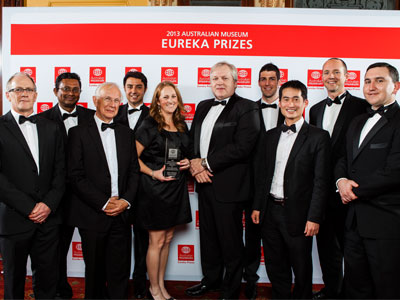Vehicle armour research wins DSTO Eureka Prize

A team of scientists behind the development of innovative vehicle armour manufacturing techniques and materials has been awarded the 2013 DSTO Eureka Prize for Outstanding Science in Safeguarding Australia.
The $10,000 prize was presented at the Australian Museum Eureka Prize awards function in Sydney last night by the Chief Defence Scientist, Dr Alex Zelinsky.
Sponsored by DSTO, the prize recognises outstanding science in support of Defence or national security.
“I congratulate the team on their award and commend them for their role in helping protect our Defence personnel against blast and ballistic threats,” Dr Zelinsky said.
The team, comprising scientists and engineers from universities, industry and research agencies across Australia, is collaborating on the Armour Applications Program under the auspices of the Defence Materials Technology Centre (DMTC).
The program is looking at ways to reduce weight, increase mobility and improve the carrying capacity of vehicles, while providing superior vehicle and personnel protection.
“In addition to researching new protective materials, the team is exploring ways to optimise manufacturing techniques to ensure that Australian defence industry can deliver high quality products at an internationally competitive price,” Dr Zelinsky said.
The team has already achieved significant results, including the development of a new welding process that has potential to reduce welding time by about a third and consumables by half, while maintaining joint integrity equivalent to the current industry standard.
“Thanks to the work of this team, Australia will retain an in-country capability to design and manufacture high performance protected mobility vehicles,” Dr Zelinsky said.
The program involves scientists and engineers from the University of Wollongong, the University of Melbourne, Swinburne University of Technology, Thales, Bisalloy and Bluescope Steel and the Australian Nuclear Science and Technology Organisation.
Dr Zelinsky said the collaboration of these participating organisations has been crucial in successfully transitioning fundamental and innovative scientific research into engineering solutions for the Australian Defence Force.

